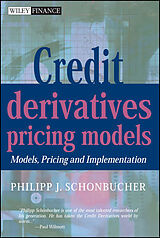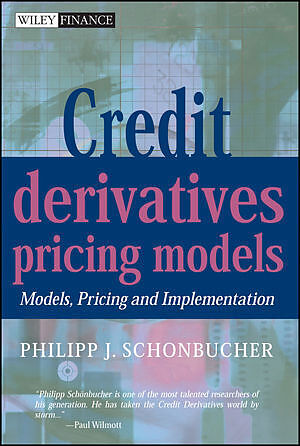Credit Derivatives Pricing Models
Einband:
Fester Einband
EAN:
9780470842911
Untertitel:
Models, Pricing and Implementation
Genre:
Betriebswirtschaft
Autor:
Philipp J. (ETH Zurich, Switzerland) Schonbucher
Herausgeber:
John Wiley & Sons
Auflage:
1. Auflage
Anzahl Seiten:
400
Erscheinungsdatum:
16.05.2003
ISBN:
978-0-470-84291-1
The purpose of this book is to provide a comprehensive overview of the state-of-the-art in credit risk modeling as applied to the pricing of credit derivatives. The credit derivatives market is booming and expanding into areas of banking that has had little exposure to quantitative models before, forcing a large number of people to confront this issue for the first time.
Autorentext
PHILIPP J. SCHÖNBUCHER is Assistant Professor for Risk Management in the Mathematics Department at ETH Zurich. He has been an active researcher in the areas of credit risk modelling and credit derivatives pricing for the past seven years. His contributions include models for the term structure of credit spreads and the dynamic copula-approach for portfolio credit risk. Through his activities in training and consulting on credit derivatives he has gained valuable insights into the usability, strengths and weaknesses of the different credit derivatives pricing models in a practical context. Dr. Schönbucher holds a M.Sc. in mathematics from Oxford University, and diploma and a Ph.D in economics from Bonn University.
Klappentext
The credit derivatives market is booming and, for the first time, expanding into the banking sector which previously has had very little exposure to quantitative modeling. This phenomenon has forced a large number of professionals to confront this issue for the first time. Credit Derivatives Pricing Models provides an extremely comprehensive overview of the most current areas in credit risk modeling as applied to the pricing of credit derivatives. As one of the first books to uniquely focus on pricing, this title is also an excellent complement to other books on the application of credit derivatives. Based on proven techniques that have been tested time and again, this comprehensive resource provides readers with the knowledge and guidance to effectively use credit derivatives pricing models. Filled with relevant examples that are applied to real-world pricing problems, Credit Derivatives Pricing Models paves a clear path for a better understanding of this complex issue. Dr. Philippe J. Schonbucher is a professor at the University of Bonn, Germany, and has degrees in mathematics from Oxford University and a PhD in economics from Bonn University. He has taught various training courses organized by ICM and CIFT, and lectured at risk conferences for practitioners on credit derivatives pricing, credit risk modeling, and implementation.
Inhalt
Preface xi Acknowledgements xv Abbreviations xvii Notation xix 1 Introduction 1 1.1 The world of credit risk 1 1.2 The components of credit risk 2 1.3 Market structure 4 2 Credit Derivatives: Overview and Hedge-Based Pricing 7 2.1 The emergence of a new class of derivatives 7 2.2 Terminology 7 2.3 Underlying assets 10 2.3.1 Loans 10 2.3.2 Bonds 11 2.3.3 Convertible bonds 12 2.3.4 Counterparty risk 12 2.4 Asset swaps 12 2.5 Total return swaps 13 2.6 Credit default swaps 15 2.7 Hedge-based pricing 19 2.7.1 Hedge instruments 20 2.7.2 Short positions in defaultable bonds 20 2.7.3 Asset swap packages 22 2.7.4 Total return swaps 25 2.7.5 Credit default swaps 27 2.8 Exotic credit derivatives 37 2.8.1 Default digital swaps 37 2.8.2 Exotic default payments in credit default swaps 38 2.8.3 Rating-triggered credit default swaps 39 2.8.4 Options on defaultable bonds 40 2.8.5 Credit spread options 41 2.9 Default correlation products and CDOs 43 2.9.1 First-to-default swaps and basket default swaps 43 2.9.2 First loss layers 44 2.9.3 Collateralised debt obligations 46 2.10 Credit-linked notes 49 2.11 Guide to the literature 50 3 Credit Spreads and Bond Price-Based Pricing 51 3.1 Credit spreads and implied default probabilities 52 3.1.1 Risk-neutral probabilities 52 3.1.2 Setup 52 3.1.3 The fundamental relationship 54 3.1.4 The implied survival probability 54 3.1.5 Conditional survival probabilities and implied hazard rates 56 3.1.6 Relation to forward spreads 58 3.2 Recovery modelling 60 3.3 Building blocks for credit derivatives pricing 61 3.4 Pricing with the building blocks 64 3.4.1 Defaultable fixed-coupon bond 64 3.4.2 Defaultable floater 65 3.4.3 Variants of coupon bonds 66 3.4.4 Credit default swaps 66 3.4.5 Forward start CDSs 68 3.4.6 Default digital swaps 68 3.4.7 Asset swap packages 69 3.5 Constructing and calibrating credit spread curves 69 3.5.1 Parametric forms for the spread curves 70 3.5.2 Semi-parametric and non-parametric calibration 72 3.5.3 Approximative and aggregate fits 74 3.5.4 Calibration example 75 3.6 Spread curves: issues in implementation 77 3.6.1 Which default-free interest rates should one use? 77 3.6.2 Recovery uncertainty 79 3.6.3 Bucket hedging 81 3.7 Spread curves: discussion 82 3.8 Guide to the literature 83 4 Mathematical Background 85 4.1 Stopping times 86 4.2 The hazard rate 87 4.3 Point processes 88 4.4 The intensity 88 4.5 Marked point processes and the jump measure 91 4.6 The compensator measure 93 4.6.1 Random measures in discrete time 95 4.7 Examples for compensator measures 97 4.8 Itô's lemma for jump processes 100 4.9 Applications of Itô's lemma 101 4.9.1 Predictable compensators for jump processes 102 4.9.2 Itô product rule and Itô quotient rule 103 4.9.3 The stochastic exponential 104 4.10 Martingale measure, fundamental pricing rule and incompleteness 105 4.11 Change of numeraire and pricing measure 107 4.11.1 The Radon-Nikodym theorem 107 4.11.2 The Girsanov theorem 108 4.12 The change of measure/change of numeraire technique 109 5 Advanced Credit Spread Models 111 5.1 Poisson processes 111 5.1.1 A model for default arrival risk 111 5.1.2 Intuitive construction of a Poisson process 112 5.1.3 Properties of Poisson processes 113 5.1.4 Spreads with Poisson processes 115 5.2 Inhomogeneous Poisson processes 115 5.2.1 Pricing the building blocks 117 5.3 Stochastic credit spreads 118 5.3.1 Cox processes 119 5.3.2 Pricing the building blocks 125 5.3.3 General point processes 126 5.3.4 Compound Poisson processes 128 6 Recovery Modelling 131 6.1 Presentation of the different recovery models 132 6.1.1 Zero recovery 132 6.1.2 Recovery of treasury 133 6.1.3 Multiple defaults and recovery of market value 135 6.1.4 Recovery of par 141 6.1.5 Stochastic recovery and recovery risk 143 6.1.6 Common parametric distribution functions for recoveries 147 6.1.7 Valuation of the delivery option in a CDS 148 6.2 Comparing the recovery models 150 6.2.1 Theoretical comparison of the recovery models 150 6.2.2 Empirical analysis of recovery rates 159 7 Implementation of Intensity-Based Models 165 7.1 Tractable models of the spot intensity 166 7.1.1 The two-factor Gaussian model 167 7.1.2 The multifactor Gaussian model 171 7.1.3 Implied survival probabilities 172 7.1.4 Payoffs at default 174 7.2 The multifactor CIR model 174 7.2.1 Bond prices 175 7.2.2 Affine combinations of independent non-central chi-squared distributed random variables 176 7.2.3 Factor distributions 178 7.3 Credit derivatives in the CIR model 179 7.3.1 Default d…

Leider konnten wir für diesen Artikel keine Preise ermitteln ...
billigbuch.ch sucht jetzt für Sie die besten Angebote ...
Die aktuellen Verkaufspreise von 6 Onlineshops werden in Realtime abgefragt.
Sie können das gewünschte Produkt anschliessend direkt beim Anbieter Ihrer Wahl bestellen.
Loading...
Die aktuellen Verkaufspreise von 6 Onlineshops werden in Realtime abgefragt.
Sie können das gewünschte Produkt anschliessend direkt beim Anbieter Ihrer Wahl bestellen.
| # | Onlineshop | Preis CHF | Versand CHF | Total CHF | ||
|---|---|---|---|---|---|---|
| 1 | Seller | 0.00 | 0.00 | 0.00 |
